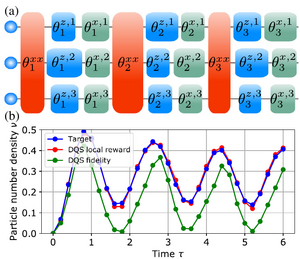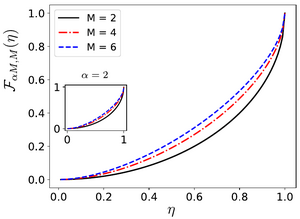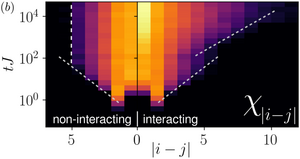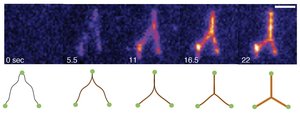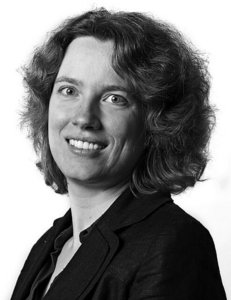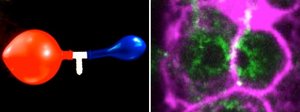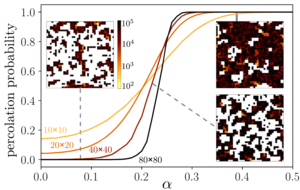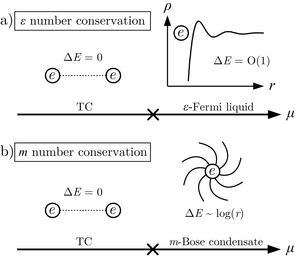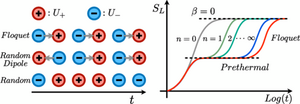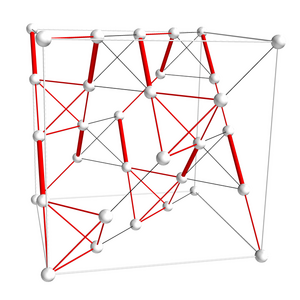
Highlights
Publication Highlights
Reinforcement Learning for Digital Quantum Simulation
Digital quantum simulation on quantum computers provides the potential to simulate the unitary evolution of any many-body Hamiltonian with bounded spectrum by discretizing the time evolution operator through a sequence of elementary quantum gates. A fundamental challenge in this context originates from experimental imperfections, which critically limits the number of attainable gates within a reasonable accuracy and therefore the achievable system sizes and simulation times. In this work, we introduce a reinforcement learning algorithm to systematically build optimized quantum circuits for digital quantum simulation upon imposing a strong constraint on the number of quantum gates. With this we consistently obtain quantum circuits that reproduce physical observables with as little as three entangling gates for long times and large system sizes up to 16 qubits. As concrete examples we apply our formalism to a long-range Ising chain and the lattice Schwinger model. Our method demonstrates that digital quantum simulation on noisy intermediate scale quantum devices can be pushed to much larger scale within the current experimental technology by a suitable engineering of quantum circuits using reinforcement learning.
A. Bolens et al., Phys. Rev. Lett. 127, 110502 (2021).
Read moreA. Bolens et al., Phys. Rev. Lett. 127, 110502 (2021).
Publication Highlights
Machine learning universal bosonic functionals
The one-body reduced density matrix $\gamma$ plays a fundamental role in describing and predicting quantum features of bosonic systems, such as Bose-Einstein condensation. The recently proposed reduced density matrix functional theory for bosonic ground states establishes the existence of a universal functional $F[\gamma]$ that recovers quantum correlations exactly. Based on a decomposition of $\gamma$, we have developed a method to design reliable approximations for such universal functionals: Our results suggest that for translational invariant systems the constrained search approach of functional theories can be transformed into an unconstrained problem through a parametrization of a Euclidian space. This simplification of the search approach allows us to use standard machine learning methods to perform a quite efficient computation of both $F[\gamma]$ and its functional derivative. For the Bose-Hubbard model, we present a comparison between our approach and the quantum Monte Carlo method.
J. Schmidt et al., Phys. Rev. Res. 3, L032063 (2021).
Read moreJ. Schmidt et al., Phys. Rev. Res. 3, L032063 (2021).
Publication Highlights
Unitary long-time evolution with quantum renormalization groups and artificial neural networks
We combine quantum renormalization group approaches with deep artificial neural networks for the description of the real-time evolution in strongly disordered quantum matter. We find that this allows us to accurately compute the long-time coherent dynamics of large many-body localized systems in nonperturbative regimes including the effects of many-body resonances. Concretely, we use this approach to describe the spatiotemporal buildup of many-body localized spin-glass order in random Ising chains. We observe a fundamental difference to a noninteracting Anderson insulating Ising chain, where the order only develops over a finite spatial range. We further apply the approach to strongly disordered two-dimensional Ising models, highlighting that our method can be used also for the description of the real-time dynamics of nonergodic quantum matter in a general context.
H. Burau et al., Phys. Rev. Lett. 127, 050601 (2021)
Read moreH. Burau et al., Phys. Rev. Lett. 127, 050601 (2021)
Publication Highlights
Unraveling forces within the nucleus
Understanding how individual proteins work together to perform complex cellular processes such as transcription, DNA replication, and repair represents a crucial goal in cell biology. Transcription is a process in the nucleus where protein complexes work together to generate transcripts of RNA from genes. For proper transcriptional regulation, enhancers—short strips of DNA—must be brought into close proximity of the gene’s promoter. Given that enhancers and promoters are often located far apart within the genome, the question then arises: how do proteins bring these enhancers and promoters together in space and time? And what are the physics behind it?
Answering these questions would provide deep insights into the proper regulation of transcription in the cell nucleus. However, extracting such information is far from trivial. But recent work from the research group of Jan Brugués at the Max Planck Institute of Molecular Cell Biology and Genetics in collaboration with Frank Jülicher at the MPI for the Physics of Complex Systems has revealed an important clue: Forces. Jan’s lab is also located at the MPI for the Physics of Complex Systems and is affiliated with the Center for Systems Biology Dresden.
Interactions between liquids and solids have long been known to generate forces, such as those maintaining the tension of a spider web or those that allow insects to walk on water. However, whether such forces play a role inside the cell has remained unclear. With the development of precise biophysical methods and advanced imaging techniques, we are getting closer to not only observing such forces but also measuring them.
The Brugués lab imaged the interactions between single molecules of DNA and the transcription factor FoxA1, a protein responsible for determining cell fate in many species. They discovered that FoxA1 molecules brought distant regions of DNA together, generating forces that condensed the DNA. When the single molecule of DNA was stretched tightly — like a tightened elastic band — FoxA1 molecules could not bring DNA together. However, when the DNA molecule was floppy, FoxA1 molecules worked together to condense the DNA, overcoming the DNA’s intrinsic tension. This new information helps paint a clearer picture of the interactions between transcriptional regulators and the surface of the DNA.
Remarkably, the physics underlying these FoxA1-DNA interactions are reminiscent of the forces that maintain the tension of a spider web. Similar to how liquid droplets on a spider web generate forces that reel in broken strands of silk, FoxA1 acts as the liquid phase that condenses DNA and brings it together.
This study demonstrated how proteins work together to generate forces in the cell nucleus. Such a result opens an exciting research direction to understanding other complex processes in the cell. Thomas Quail, post-doctoral researcher in the Brugués lab says: “Our findings set forth a novel mechanism that the cell nucleus may use to organize its chromatin and DNA. It’s possible that these condensation forces generated between solid and liquid surfaces could also be relevant for other cellular bodies such as the mitotic spindle and membranes.”
T. Quail et al., Nature Physics (2021)
Read moreAnswering these questions would provide deep insights into the proper regulation of transcription in the cell nucleus. However, extracting such information is far from trivial. But recent work from the research group of Jan Brugués at the Max Planck Institute of Molecular Cell Biology and Genetics in collaboration with Frank Jülicher at the MPI for the Physics of Complex Systems has revealed an important clue: Forces. Jan’s lab is also located at the MPI for the Physics of Complex Systems and is affiliated with the Center for Systems Biology Dresden.
Interactions between liquids and solids have long been known to generate forces, such as those maintaining the tension of a spider web or those that allow insects to walk on water. However, whether such forces play a role inside the cell has remained unclear. With the development of precise biophysical methods and advanced imaging techniques, we are getting closer to not only observing such forces but also measuring them.
The Brugués lab imaged the interactions between single molecules of DNA and the transcription factor FoxA1, a protein responsible for determining cell fate in many species. They discovered that FoxA1 molecules brought distant regions of DNA together, generating forces that condensed the DNA. When the single molecule of DNA was stretched tightly — like a tightened elastic band — FoxA1 molecules could not bring DNA together. However, when the DNA molecule was floppy, FoxA1 molecules worked together to condense the DNA, overcoming the DNA’s intrinsic tension. This new information helps paint a clearer picture of the interactions between transcriptional regulators and the surface of the DNA.
Remarkably, the physics underlying these FoxA1-DNA interactions are reminiscent of the forces that maintain the tension of a spider web. Similar to how liquid droplets on a spider web generate forces that reel in broken strands of silk, FoxA1 acts as the liquid phase that condenses DNA and brings it together.
This study demonstrated how proteins work together to generate forces in the cell nucleus. Such a result opens an exciting research direction to understanding other complex processes in the cell. Thomas Quail, post-doctoral researcher in the Brugués lab says: “Our findings set forth a novel mechanism that the cell nucleus may use to organize its chromatin and DNA. It’s possible that these condensation forces generated between solid and liquid surfaces could also be relevant for other cellular bodies such as the mitotic spindle and membranes.”
T. Quail et al., Nature Physics (2021)
Awards and Honors
Physik-Preis Dresden zum fünften Mal verliehen
Am 6. Juli 2021 wurde der „Physik-Preis Dresden“ der TU Dresden und des Max-Planck-Instituts für Physik komplexer Systeme (MPI-PKS) zum fünften Mal verliehen.
Der Physik-Preis Dresden 2021 geht an Professor Gijsje Koenderink von der Technischen Universität Delft. Gijsje Koenderink ist eine herausragende experimentelle Biophysikerin mit einer Reihe von bahnbrechenden Arbeiten zur Zellmechanik und zellulären Krafterzeugung.
In Anerkennung ihrer hervorragenden Beiträge zur Physik der Zellen erhält Gijsje Koenderink den Dresdner Physikpreis 2021, der gemeinsam vom Max-Planck-Institut für Physik komplexer Systeme und der TU Dresden verliehen wird.
Die Forschung von Gijsje Koenderink ist von großem Interesse für eine Reihe von Forschungsgruppen in Dresden, insbesondere im Rahmen des Exzellenzclusters "Physik des Lebens". Die Verleihung des Physik-Preis Dresden 2021 an Professor Koenderink schafft eine wertvolle Verbindung zwischen ihrer Forschungsgruppe und der Forschung auf den Gebieten Polymerphysik, weicher kondensierter Materie, Biophysik und Zellbiologie in Dresden.
Gastgeber des Abends, Prof. Dr. Frank Jülicher, Direktor am Max-Planck-Institut für Physik komplexer Systeme, war überaus erfreut, dass mit Gijsje Koenderink eine so bedeutende internationale Forscherpersönlichkeit geehrt wurde.
Der Physik-Preis Dresden wurde 2015 von dem Dresdner Physiker Prof. Peter Fulde, dem Gründungsdirektor des MPI-PKS gestiftet. Die Preisträger werden von einer gemeinsamen Kommission der TU Dresden und des MPI-PKS bestimmt. Neben dem zentralen Kriterium der wissenschaftlichen Exzellenz ist für die Entscheidung vor allem wichtig, dass die Arbeiten der Preisträger für die Zusammenarbeit zwischen beiden Dresden-concept Partnern MPI-PKS und TU Dresden von besonderer Bedeutung sind und deren Verbindung langfristig weiter gestärkt wurde.
Read morePublication Highlights
Hydraulic instability decides who’s to die and who’s to live
In many species including humans, the cells responsible for reproduction, the germ cells, are often highly interconnected and share their cytoplasm. In the hermaphrodite nematode Caenorhabditis elegans, up to 500 germ cells are connected to each other in the gonad, the tissue that produces eggs and sperm. These cells are arranged around a central cytoplasmic “corridor” and exchange cytoplasmic material fostering cell growth, and ultimately produce oocytes ready to be fertilized.
In past studies, researchers have found that C. elegans gonads generate more germ cells than needed. Only half of them grow to become oocytes, while the rest shrinks and die by physiological apoptosis, a programmed cell death that occurs in multicellular organisms. Now, scientists from the Biotechnology Center of the TU Dresden (BIOTEC), the Max Planck Institute of Molecular Cell Biology and Genetics (MPI-CBG), the Cluster of Excellence Physics of Life (PoL) at the TU Dresden, the Max Planck Institute for the Physics of Complex Systems (MPI-PKS), the Flatiron Institute, NY, and the University of California, Berkeley, found evidence to answer the question of what triggers this cell fate decision between life and death in the germline. Prior studies revealed the genetic basis and biochemical signals that drive physiological cell death, but the mechanisms that select and initiate apoptosis in individual germ cells remained unclear. As germ cells mature along the gonad of the nematode, they first collectively grow in size and in volume homogenously. In the study just published in Nature Physics, the scientists show that this homogenous growth suddenly shifts to a heterogenous growth where some cells become bigger and some cells become smaller.
The researcher Nicolas Chartier in the group of Stephan Grill, and co-first author of the study, explains: “By precisely analyzing germ cell volumes and cytoplasmic material fluxes in living worms and by developing theoretical modeling, we have identified a hydraulic instability that amplifies small initial random volume differences, which causes some germ cells to increase in volume at the expense of the others that shrink. It is a phenomenon, which can be compared to the two-balloon instability, well known of physicists. Such an instability arises when simultaneously blowing into two rubber balloons attempting to inflate them both. Only the larger balloon will inflate, because it has a lower internal pressure than the smaller one, and is therefore easier to inflate.” This is what is at play in the selection of germ cells: such pressure differences tend to destabilize the symmetric configuration with equal germ cell volumes, so-called hydraulic instabilities, leading to the growth of the larger germ cell at the expense of the smaller one. By artificially reducing germ cell volumes via thermoviscous pumping (FLUCS method: focused-light-induced cytoplasmic streaming), the team demonstrated that the reduction in cell volumes leads to their extrusion and cell death, indicating that once a cell is below a critical size, apoptosis is induced and the cell dies. By using confocal imaging, the researchers could image the full organism of the living worm to receive a global and precise picture of the volumes of all the gonad cells, as well as the exchange of fluids between the cells. Stephan Grill, Speaker of the PoL and director at the MPI-CBG and supervisor of the multidisciplinary work, adds: “These findings are very exciting because they reveal that the life and death decision in the cells is of mechanical nature and related to tissue hydraulics. It helps to understand how the organism auto-selects a cell that will become an egg. Furthermore, the study is another example of the excellent cooperation between biologists, physicists and mathematicians in Dresden.”
T. Chartier et al., Nature Physics (2021)
Read moreIn past studies, researchers have found that C. elegans gonads generate more germ cells than needed. Only half of them grow to become oocytes, while the rest shrinks and die by physiological apoptosis, a programmed cell death that occurs in multicellular organisms. Now, scientists from the Biotechnology Center of the TU Dresden (BIOTEC), the Max Planck Institute of Molecular Cell Biology and Genetics (MPI-CBG), the Cluster of Excellence Physics of Life (PoL) at the TU Dresden, the Max Planck Institute for the Physics of Complex Systems (MPI-PKS), the Flatiron Institute, NY, and the University of California, Berkeley, found evidence to answer the question of what triggers this cell fate decision between life and death in the germline. Prior studies revealed the genetic basis and biochemical signals that drive physiological cell death, but the mechanisms that select and initiate apoptosis in individual germ cells remained unclear. As germ cells mature along the gonad of the nematode, they first collectively grow in size and in volume homogenously. In the study just published in Nature Physics, the scientists show that this homogenous growth suddenly shifts to a heterogenous growth where some cells become bigger and some cells become smaller.
The researcher Nicolas Chartier in the group of Stephan Grill, and co-first author of the study, explains: “By precisely analyzing germ cell volumes and cytoplasmic material fluxes in living worms and by developing theoretical modeling, we have identified a hydraulic instability that amplifies small initial random volume differences, which causes some germ cells to increase in volume at the expense of the others that shrink. It is a phenomenon, which can be compared to the two-balloon instability, well known of physicists. Such an instability arises when simultaneously blowing into two rubber balloons attempting to inflate them both. Only the larger balloon will inflate, because it has a lower internal pressure than the smaller one, and is therefore easier to inflate.” This is what is at play in the selection of germ cells: such pressure differences tend to destabilize the symmetric configuration with equal germ cell volumes, so-called hydraulic instabilities, leading to the growth of the larger germ cell at the expense of the smaller one. By artificially reducing germ cell volumes via thermoviscous pumping (FLUCS method: focused-light-induced cytoplasmic streaming), the team demonstrated that the reduction in cell volumes leads to their extrusion and cell death, indicating that once a cell is below a critical size, apoptosis is induced and the cell dies. By using confocal imaging, the researchers could image the full organism of the living worm to receive a global and precise picture of the volumes of all the gonad cells, as well as the exchange of fluids between the cells. Stephan Grill, Speaker of the PoL and director at the MPI-CBG and supervisor of the multidisciplinary work, adds: “These findings are very exciting because they reveal that the life and death decision in the cells is of mechanical nature and related to tissue hydraulics. It helps to understand how the organism auto-selects a cell that will become an egg. Furthermore, the study is another example of the excellent cooperation between biologists, physicists and mathematicians in Dresden.”
T. Chartier et al., Nature Physics (2021)
Publication Highlights
Disorder-Free Localization in an Interacting 2D Lattice Gauge Theory
Disorder-free localization has been recently introduced as a mechanism for ergodicity breaking in low-dimensional homogeneous lattice gauge theories caused by local constraints imposed by gauge invariance. We show that also genuinely interacting systems in two spatial dimensions can become nonergodic as a consequence of this mechanism. This result is all the more surprising since the conventional many-body localization is conjectured to be unstable in two dimensions; hence the gauge invariance represents an alternative robust localization mechanism surviving in higher dimensions in the presence of interactions. Specifically, we demonstrate nonergodic behavior in the quantum link model by obtaining a bound on the localization-delocalization transition through a classical correlated percolation problem implying a fragmentation of Hilbert space on the nonergodic side of the transition. We study the quantum dynamics in this system by introducing the method of “variational classical networks,” an efficient and perturbatively controlled representation of the wave function in terms of a network of classical spins akin to artificial neural networks. We identify a distinguishing dynamical signature by studying the propagation of line defects, yielding different light cone structures in the localized and ergodic phases, respectively. The methods we introduce in this work can be applied to any lattice gauge theory with finite-dimensional local Hilbert spaces irrespective of spatial dimensionality.
P. Karpov et al., Phys. Rev. Lett. 126, 130401 (2021).
Read moreP. Karpov et al., Phys. Rev. Lett. 126, 130401 (2021).
Publication Highlights
Anatomy of $\mathbb{Z}_2$ fluxes in anyon Fermi liquids and Bose condensates
We study in detail the properties of $\pi$-fluxes embedded in a state with a finite density of anyons that form either a Fermi liquid or a Bose-Einstein condensate. By employing a recently developed exact lattice bosonization in 2D, we demonstrate that such $\pi$-flux remains a fully deconfined quasi-particle with a finite energy cost in a Fermi liquid of emergent fermions coupled to a $\mathbb{Z}_2$ gauge field. This $\pi$-flux is accompanied by a screening cloud of fermions, which in the case of a Fermi gas with a parabolic dispersion binds exactly 1/8 of a fermionic hole. In addition there is a long-ranged power-law oscillatory disturbance of the liquid surrounding the $\pi$-flux akin to Friedel oscillations. These results carry over directly to the $\pi$-flux excitations in orthogonal metals. In sharp contrast, when the $\pi$-flux is surrounded by a Bose-Einstein condensate of particles coupled to a $\mathbb{Z}_2$ gauge field, it binds a superfluid half-vortex, becoming a marginally confined excitation with a logarithmic energy cost divergence.
O. Pozo et al., Phys. Rev. B 103, 035145 (2021)
Read moreO. Pozo et al., Phys. Rev. B 103, 035145 (2021)
Publication Highlights
Random Multipolar Driving: Tunably Slow Heating through Spectral Engineering
Driven quantum systems may realize novel phenomena absent in static systems, but driving-induced heating can limit the timescale on which these persist. We study heating in interacting quantum many-body systems driven by random sequences with n-multipolar correlations, corresponding to a polynomially suppressed low-frequency spectrum. For $n\geq 1$, we find a prethermal regime, the lifetime of which grows algebraically with the driving rate, with exponent $2n+1$. A simple theory based on Fermi’s golden rule accounts for this behavior. The quasiperiodic Thue-Morse sequence corresponds to the $n\to \infty$ limit and, accordingly, exhibits an exponentially long-lived prethermal regime. Despite the absence of periodicity in the drive, and in spite of its eventual heat death, the prethermal regime can host versatile nonequilibrium phases, which we illustrate with a random multipolar discrete time crystal.
H. Zhao et al., Phys. Rev. Lett. 126, 040601 (2021).
Read moreH. Zhao et al., Phys. Rev. Lett. 126, 040601 (2021).
Publication Highlights
Possible Inversion Symmetry Breaking in the $S=1/2$ Pyrochlore Heisenberg Magnet
We address the ground-state properties of the long-standing and much-studied three-dimensional quantum spin liquid candidate, the $S=1/2$ pyrochlore Heisenberg antiferromagnet. By using SU(2) density-matrix renormalization group (DMRG), we are able to access cluster sizes of up to 128 spins. Our most striking finding is a robust spontaneous inversion symmetry breaking, reflected in an energy density difference between the two sublattices of tetrahedra, familiar as a starting point of earlier perturbative treatments. We also determine the ground-state energy, $E_0/N_{sites}=-0.490(6)$, by combining extrapolations of DMRG with those of a numerical linked cluster expansion. These findings suggest a scenario in which a finite-temperature spin liquid regime gives way to a symmetry-broken state at low temperatures.
I. Hagymási et al., Phys. Rev. Lett. 126, 117204 (2021)
Read moreI. Hagymási et al., Phys. Rev. Lett. 126, 117204 (2021)

